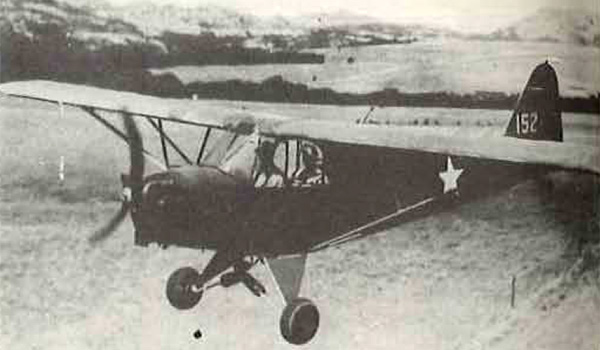
By Mark Albertson: By 1941, it was certain as sunrise that America would soon be in the global conflict raging outside its borders. And this meant that the armed forces needed to prepare for that eventuality.

L-4 Piper Cub
The schedule of Army war games kicked off in Tennessee in June with Second Army; then it was on to Fort Bliss in Texas with Third Army in July. August and September were in Louisiana with Second and Third Armies, followed in October and November in the Carolinas with First Army and IV Corps.
The maneuvers centered at Fort Bliss were held July 15-26, 1941. On the first day, Henry Wann, a Piper employee who was taking part, departed Biggs Field for the 1st Cavalry Division HQ located in the desert. Wann touched down on a surface of sand, tufts of grass and cactus. He bounced to a quick stop and hopped out of his J-3. He reported to Major General Innis P. Swift, who remarked, “You looked like a damn grasshopper when you landed that thing out there in those boondocks and bounced around.” In addition, Wann touched down some 45 minutes before a dispatch rider detailed to alert General Swift of the pilot’s arrival.
General Swift was losing patience with the troublesome radio communications between the desert and his headquarters. So he found another chore for Wann. He ordered his aide, “Send a Grasshopper down to Biggs Hill.” His aide was befuddled. “What’s a Grasshopper?” Swift replied, “They’ll know when you tell him.”
A legend had been born. The name stuck and within a month, ‘Grasshopper’ pins and fuselage markings appeared on the fuselages of the flivver planes attached to the maneuvers.
Sources: Brown, Major Robert S., USA, The Development of Organic Light Aviation in the Army Ground Forces in World War II, Army Command and General Staff College, Fort Leavenworth, KS., 2000.
Francis, Devon, Mr. Piper and His Cubs, Iowa State University Press, Ames, Iowa, 1973.
Tierney, Richard K., “The Army Aviation Story,” Part I, United States Army Aviation Digest, June 1962.








